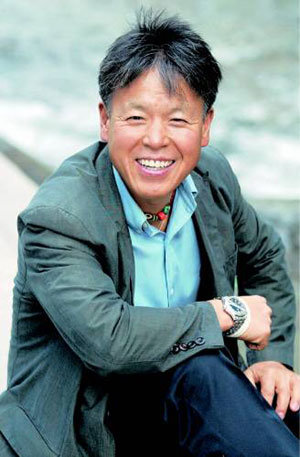Mountain Climber Is Humanist at Heart
Mountain Climber Is Humanist at Heart
Posted November. 02, 2005 05:07,

Man is the most valuable commodity in the world, says mountain climber Um Hong-il. In that respect, I pride myself in being a humanist.
Um (45, director of Treksta and the Pagoda Academy) was the first Asian to climb the 14 8,000m peaks of the Himalayas after reaching the summit of K2 (8,611 meters above sea-level), regarded as the most difficult and dangerous Himalayan peak of all, on July 31, 2000.
He began his assault on the peaks in 1985 with an attempt on Mt. Everest, and has been climbing the high peaks of the Himalayas ever since. But his heart has always given more love to people than to mountains.
I am a humanist
Um will leave for Nepal on November 5 and visit Pangboche, a village 3,800 meters above sea-level on Mt. Everest. But he is not making this visit to climb the worlds highest mountain again, which he has completed three times in six tries. He is planning to meet the family of a Sherpa who lost his life during one of his Everest expeditions in 1986 and deliver consolation money. Um created a scholarship fund worth 300 million won with the help of his company, Treksta, for the family of the Sherpa.
This May, Um retrieved the body of Park Moo-taek (a member of the Keimyung University Everest Expedition team) right below the summit of the mountain, some 8,750 meters above sea-level, which touched the hearts of many. Park had been killed in an accident in May 2004 during a climb. Um called the team that was sent to retrieve the body the Human Expedition team.
Um started climbing the Himalayas in his 20s-
Um was born in Goseong, Gyeongnam Province, and moved to Uijeongbu, Gyeonggi Province at the age of three. His parents ran a business at the entrance of Mangweol temple at Mt. Dobong, and he had climbed the mountain like a squirrel ever since he was a toddler. He applied to become a member of the military underwater demolition teams, and after finishing his military services in 1984, he started his Himalayan ascents with the encouragement of his senior the year after. His first challenge was Mt. Everest, the highest mountain in the world. He climbed 7,800 meters in 1985, 8,800 meters in 1986, and finally conquered the mountain in 1988.
I should have just died on the mountain instead of coming back down
His path to conquer the 14 8,000-meter peaks of the Himalayas was filled with years of bitter adversity. In particular, after his conquest of Mt. Everest in 1988, he challenged the high peaks of the Himalayas six times until 1992, including Annapurna (8,091 meters above sea-level), but failed all six attempts. On his climb to Nanga Parbat (8,125 meters above sea-level), he lost the first and second toes of his right foot to frostbite.
Um completed the 14 Himalayan peaks after conquering K2 in 2000, but controversy over his climbs was waiting for him when he came back. His ascents of Shishapangma (8,027 meters above sea-level) in 1993 and Lhotse (8,516 meters above sea-level) in 1995 were the targets of criticism. I completed my climbs to the summits and therefore have nothing to be ashamed of, but there are people who keep trying to cut me down. There are times when I think it would have been better if I had just died in the mountains.
In response to his critics, he then climbed the two mountains again in 2001. His climbs to the high peaks are still to be continued.
Chang Jeon jeon@donga.com







